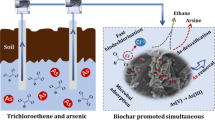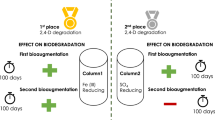Abstract
Herbicide use in agriculture is important to increase crop yield; however, it has caused groundwater contamination in some countries. Our objective was to develop a slow-release reductant to treat herbicide-contaminated groundwater. The tested herbicides were alachlor (ALC), metolachlor (MTC), 2,4-dichlorophenoxyacetic acid (2,4-D), and atrazine (ATZ). Among these, ALC degraded the best, reaching a degradation plateau with a small level of Fe0 (2.5%, w/v). Under aerobic conditions, both reductive reactions for electron transfer and oxidative reactions for generating active radicals are complex reactions responsible for herbicide degradation. By using slow-release Fe0 (SRZ), we found that the degradation was prolonged and the plateau disappeared, indicating the greatest slow-release benefit. Fe0 and SRZ removed ALC at 15% and 28% faster rates, respectively, under anaerobic conditions. At pH 3, the oxide layers on Fe0 were removed facilitating better electron transfer for ALC degradation. Several reductants were tested in this study, but we mainly used Fe0 as the main slow-release ingredient that was prepared by mixing Fe0 with heated paraffin in a 4.7:1 ratio (w/w) and molding it into a 0.6 cm ∅ × 2.5 cm length cylindrical shape. We stacked slow-release Fe0 in a 2D ALC-saturated sand tank (70 × 30 × 3 cm), spatially collected samples along with the tank sampling array, and quantified the changes in ALC concentration. The results showed that the ALC concentration decreased 20–35% faster compared to DI flushing. These results supported the use of SRZ as an alternative approach for treating herbicide-contaminated groundwater.









Similar content being viewed by others
Data Availability
The datasets supporting the conclusions of this article are included within the article.
References
Angkaew, A., Chokejaroenrat, C., Sakulthaew, C., Mao, J., Watcharatharapong, T., Watcharenwong, A., Imman, S., Suriyachai, N., & Kreetachat, T. (2021). Two facile synthesis routes for magnetic recoverable MnFe2O4/g-C3N4 nanocomposites to enhance visible light photo-Fenton activity for methylene blue degradation. Journal of Environmental Chemical Engineering, 9(4), 105621. https://doi.org/10.1016/j.jece.2021.105621
Ballesteros Martín, M. M., Sánchez Pérez, J. A., García Sánchez, J. L., Montes de Oca, L., Casas López, J. L., Oller, I., & Malato Rodríguez, S. (2008). Degradation of alachlor and pyrimethanil by combined photo-Fenton and biological oxidation. Journal of Hazardous Materials, 155(1), 342–349. https://doi.org/10.1016/j.jhazmat.2007.11.069
Bexfield, L. M., Belitz, K., Lindsey, B. D., Toccalino, P. L., & Nowell, L. H. (2021). Pesticides and pesticide degradates in groundwater used for public supply across the United States: Occurrence and human-health context. Environmental Science & Technology, 55(1), 362–372. https://doi.org/10.1021/acs.est.0c05793
Bezbaruah, A. N., Thompson, J. M., & Chisholm, B. J. (2009). Remediation of alachlor and atrazine contaminated water with zero-valent iron nanoparticles. Journal of Environmental Science and Health, Part B, 44(6), 518–524. https://doi.org/10.1080/03601230902997501
Bielski, B. H. J., Cabelli, D. E., Arudi, R. L., & Ross, A. B. (1985). Reactivity of HO2/O−2 radicals in aqueous solution. Journal of Physical and Chemical Reference Data, 14(4), 1041–1100. https://doi.org/10.1063/1.555739
Boparai, H. K., Shea, P. J., Comfort, S. D., & Snow, D. D. (2006). Dechlorinating chloroacetanilide herbicides by dithionite-treated aquifer sediment and surface soil. Environmental Science & Technology, 40(9), 3043–3049. https://doi.org/10.1021/es051915m
Buxton, G. V., Greenstock, C. L., Helman, W. P., & Ross, A. B. (1988). Critical Review of rate constants for reactions of hydrated electrons, hydrogen atoms and hydroxyl radicals (⋅OH/⋅O− in Aqueous Solution. Journal of Physical and Chemical Reference Data, 17(2), 513–886. https://doi.org/10.1063/1.555805
Clausen, L., & Fabricius, I. (2001). Atrazine, isoproturon, mecoprop, 2,4-D, and bentazone adsorption onto iron oxides. Journal of Environmental Quality, 30(3), 858–869. https://doi.org/10.2134/jeq2001.303858x
Comfort, S. D., Shea, P. J., Machacek, T. A., Gaber, H., & Oh, B. T. (2001). Field-scale remediation of a metolachlor-contaminated spill site using zerovalent iron. Journal of Environmental Quality, 30(5), 1636–1643. https://doi.org/10.2134/jeq2001.3051636x
Correia de Velosa, A., & Pupo Nogueira, R. F. (2013). 2,4-Dichlorophenoxyacetic acid (2,4-D) degradation promoted by nanoparticulate zerovalent iron (nZVI) in aerobic suspensions. Journal of Environmental Management, 121, 72–79. https://doi.org/10.1016/j.jenvman.2013.02.031
Costa, R. C. C., Moura, F. C. C., Ardisson, J. D., Fabris, J. D., & Lago, R. M. (2008). Highly active heterogeneous Fenton-like systems based on Fe0/Fe3O4 composites prepared by controlled reduction of iron oxides. Applied Catalysis B: Environmental, 83(1), 131–139. https://doi.org/10.1016/j.apcatb.2008.01.039
Cox, C. (2005). 2,4-D. Herbicide factsheet. Retrieved June 29, 2022, from https://assets.nationbuilder.com/ncap/pages/26/attachments/original/1428423300/24d-factsheet.pdf?1428423300
Dombek, T., Dolan, E., Schultz, J., & Klarup, D. (2001). Rapid reductive dechlorination of atrazine by zero-valent iron under acidic conditions. Environmental Pollution, 111(1), 21–27. https://doi.org/10.1016/S0269-7491(00)00033-6
Eykholt, G. R., & Davenport, D. T. (1998). Dechlorination of the chloroacetanilide herbicides alachlor and metolachlor by iron metal. Environmental Science & Technology, 32(10), 1482–1487. https://doi.org/10.1021/es970678n
Filip, J., Karlický, F., Marušák, Z., Lazar, P., Černík, M., Otyepka, M., & Zbořil, R. (2014). Anaerobic reaction of nanoscale zerovalent iron with water: Mechanism and kinetics. The Journal of Physical Chemistry C, 118(25), 13817–13825. https://doi.org/10.1021/jp501846f
Fu, J., Zhang, Z.-M., Tang, J.-Y., Zeng, Q.-F., An, S.-Q., & Zhu, H.-L. (2010). Photoreduction of reactive brilliant red X-3B by ultraviolet irradiation/potassium borohydride/sodium bisulfite. Journal of Environmental Engineering, 136(11), 1314–1319. https://doi.org/10.1061/(ASCE)EE.1943-7870.0000251
Furukawa, Y., Kim, J.-W., Watkins, J., & Wilkin, R. T. (2002). Formation of ferrihydrite and associated iron corrosion products in permeable reactive barriers of zero-valent iron. Environmental Science & Technology, 36(24), 5469–5475. https://doi.org/10.1021/es025533h
Gan, H., Stucki, J. W., & Bailey, G. W. (1992). Reduction of structural iron in ferruginous smectite by free radicals. Clays and Clay Minerals, 40(6), 659–665. https://doi.org/10.1346/CCMN.1992.0400605
Gan, J., Wang, Q., Yates, S. R., Koskinen, W. C., & Jury, W. A. (2002). Dechlorination of chloroacetanilide herbicides by thiosulfate salts. Proceedings of the National Academy of Sciences, 99(8), 5189–5194. https://doi.org/10.1073/pnas.042105199
Ghauch, A., & Suptil, J. (2000). Remediation of s-triazines contaminated water in a laboratory scale apparatus using zero-valent iron powder. Chemosphere, 41(12), 1835–1843. https://doi.org/10.1016/S0045-6535(00)00133-8
Hladik, M. L., Bouwer, E. J., & Roberts, A. L. (2008). Neutral degradates of chloroacetamide herbicides: Occurrence in drinking water and removal during conventional water treatment. Water Research, 42(20), 4905–4914. https://doi.org/10.1016/j.watres.2008.09.008
Huang, Z., Tang, F., & Zhang, L. (2005). Morphology control and texture of Fe3O4 nanoparticle-coated polystyrene microspheres by ethylene glycol in forced hydrolysis reaction. Thin Solid Films, 471(1), 105–112. https://doi.org/10.1016/j.tsf.2004.04.042
Joo, S. H., & Mitch, W. A. (2007). Nitrile, aldehyde, and halonitroalkane formation during chlorination/chloramination of primary amines. Environmental Science & Technology, 41(4), 1288–1296. https://doi.org/10.1021/es0612697
Joo, S. H., & Zhao, D. (2008). Destruction of lindane and atrazine using stabilized iron nanoparticles under aerobic and anaerobic conditions: Effects of catalyst and stabilizer. Chemosphere, 70(3), 418–425. https://doi.org/10.1016/j.chemosphere.2007.06.070
Laganà, A., Bacaloni, A., De Leva, I., Faberi, A., Fago, G., & Marino, A. (2002). Occurrence and determination of herbicides and their major transformation products in environmental waters. Analytica Chimica Acta, 462(2), 187–198. https://doi.org/10.1016/S0003-2670(02)00351-3
Liu, X., Yoon, S., Batchelor, B., & Abdel-Wahab, A. (2013). Photochemical degradation of vinyl chloride with an advanced reduction process (ARP) – Effects of reagents and pH. Chemical Engineering Journal, 215–216, 868–875. https://doi.org/10.1016/j.cej.2012.11.086
Makarov. (2001). Novel trends in chemistry of sulfur-containing reductants. Uspekhi Khimii, 2001(70), 1005.
MOAC. (2021). Summary of imported pesticides into Thailand [in Thai]. Office of Agricultural Regulation, Bangkok. Retrieved June 29, 2022, from https://www.oae.go.th/view/1/%E0%B8%9B%E0%B8%B1%E0%B8%88%E0%B8%88%E0%B8%B1%E0%B8%A2%E0%B8%81%E0%B8%B2%E0%B8%A3%E0%B8%9C%E0%B8%A5%E0%B8%B4%E0%B8%95/TH-TH
Miltner, R. J., Baker, D. B., Speth, T. F., & Fronk, C. A. (1989). Treatment of seasonal pesticides in surface waters. Journal (American Water Works Association), 81(1), 43–52. Retrieved from http://www.jstor.org/stable/41292310. Accessed 30 June 2022
Noradoun, C. E., & Cheng, I. F. (2005). EDTA Degradation induced by oxygen activation in a zerovalent iron/air/water system. Environmental Science & Technology, 39(18), 7158–7163. https://doi.org/10.1021/es050137v
Olson, R.V. (1965). Iron. In Black, C.A. (Ed.), Methods of soil analysis, Part II. Amer. Soc. Agronomy, Madison, Wisconsin, (vol. 9., pp. 966–967).
Ormad, M. P., Miguel, N., Claver, A., Matesanz, J. M., & Ovelleiro, J. L. (2008). Pesticides removal in the process of drinking water production. Chemosphere, 71(1), 97–106. https://doi.org/10.1016/j.chemosphere.2007.10.006
Peller, J., Wiest, O., & Kamat, P. V. (2003). Mechanism of hydroxyl radical-induced breakdown of the herbicide 2,4-dichlorophenoxyacetic acid (2,4-D). Chemistry - A European Journal, 9(21), 5379–5387. https://doi.org/10.1002/chem.200204469
Roy, G., de Donato, P., Görner, T., & Barres, O. (2003). Study of tropaeolin degradation by iron—proposition of a reaction mechanism. Water Research, 37(20), 4954–4964. https://doi.org/10.1016/S0043-1354(03)00438-X
Samir, R., Essam, T., Ragab, Y., & Hashem, A. (2015). Enhanced photocatalytic–biological degradation of 2,4 dichlorophenoxyacetic acid. Bulletin of Faculty of Pharmacy, Cairo University, 53(2), 77–82. https://doi.org/10.1016/j.bfopcu.2015.03.002
Satapanajaru, T., Comfort, S. D., & Shea, P. J. (2003). Enhancing metolachlor destruction rates with aluminum and iron salts during zerovalent iron treatment. Journal of Environmental Quality, 32(5), 1726–1734. https://doi.org/10.2134/jeq2003.1726
Si, Y. B., Fang, G. D., Zhou, J., & Zhou, D. M. (2010). Reductive transformation of 2,4-dichlorophenoxyacetic acid by nanoscale and microscale Fe3O4 particles. Journal of Environmental Science and Health, Part B, 45(3), 233–241. https://doi.org/10.1080/03601231003613641
Singh, J., Shea, P. J., Hundal, L. S., Comfort, S. D., Zhang, T. C., & Hage, D. S. (1998). Iron-enhanced remediation of water and soil containing atrazine. Weed Science, 46(3), 381–388. http://www.jstor.org/stable/4045877.
Sun, H., Xie, G., He, D., & Zhang, L. (2020). Ascorbic acid promoted magnetite Fenton degradation of alachlor: Mechanistic insights and kinetic modeling. Applied Catalysis B: Environmental, 267, 118383. https://doi.org/10.1016/j.apcatb.2019.118383
Szecsody, J. E., Fruchter, J. S., Williams, M. D., Vermeul, V. R., & Sklarew, D. (2004). In Situ chemical reduction of aquifer sediments: Enhancement of reactive iron phases and TCE dechlorination. Environmental Science & Technology, 38(17), 4656–4663. https://doi.org/10.1021/es034756k
Telfeyan, K., Migdisov, A. A., Pandey, S., Vesselinov, V. V., & Reimus, P. W. (2019). Long-term stability of dithionite in alkaline anaerobic aqueous solution. Applied Geochemistry, 101, 160–169. https://doi.org/10.1016/j.apgeochem.2018.12.015
Thapinta, A., & Hudak, P. F. (2003). Use of geographic information systems for assessing groundwater pollution potential by pesticides in Central Thailand. Environment International, 29(1), 87–93. https://doi.org/10.1016/S0160-4120(02)00149-6
USEPA. (2022). National primary drinking water regulations. Retrieved June 29, 2022, from https://www.epa.gov/ground-water-and-drinking-water/national-primary-drinking-water-regulations
Wetchayanon, M., Kungskulniti, N., Charoenca, N., & Tangbanluekal, C. (2021). Assessment of agricultural pesticide contamination and health risk in main rivers of Thailand. Thai Journal of Science and Technology, 10(1), 109–123. https://doi.org/10.14456/tjst.2021.9
Xu, R., Kuang, R., Pay, E., Dou, H., & de Snoo, G. R. (2008). Factors contributing to overuse of pesticides in western China. Environmental Sciences, 5(4), 235–249. https://doi.org/10.1080/15693430802346543
Yuan, B., Liang, S., Jin, Y.-X., Zhang, M.-J., Zhang, J.-B., & Kim, N.-H. (2017). Toxic effects of atrazine on porcine oocytes and possible mechanisms of action. PLoS One, 12(6), e0179861. https://doi.org/10.1371/journal.pone.0179861
Zhou, T., Li, Y., Wong, F.-S., & Lu, X. (2008). Enhanced degradation of 2,4-dichlorophenol by ultrasound in a new Fenton like system (Fe/EDTA) at ambient circumstance. Ultrasonics Sonochemistry, 15(5), 782–790. https://doi.org/10.1016/j.ultsonch.2008.01.005
Funding
This research was financially supported by the Kasetsart University Research and Development Institute (KURDI) in the fiscal year 2018. Saksit Imman was supported by the unit of excellence, University of Phayao (No. FF65-UoE008 and FF65-RIM001).
Author information
Authors and Affiliations
Corresponding author
Ethics declarations
Conflict of Interest
The authors declare no competing interests.
Additional information
Publisher's Note
Springer Nature remains neutral with regard to jurisdictional claims in published maps and institutional affiliations.
Rights and permissions
Springer Nature or its licensor (e.g. a society or other partner) holds exclusive rights to this article under a publishing agreement with the author(s) or other rightsholder(s); author self-archiving of the accepted manuscript version of this article is solely governed by the terms of such publishing agreement and applicable law.
About this article
Cite this article
Chokejaroenrat, C., Angkaew, A., Techauay, K. et al. Developing Slow-Release Reductant for Treating Herbicide-Contaminated Groundwater. Water Air Soil Pollut 234, 396 (2023). https://doi.org/10.1007/s11270-023-06397-3
Received:
Accepted:
Published:
DOI: https://doi.org/10.1007/s11270-023-06397-3




